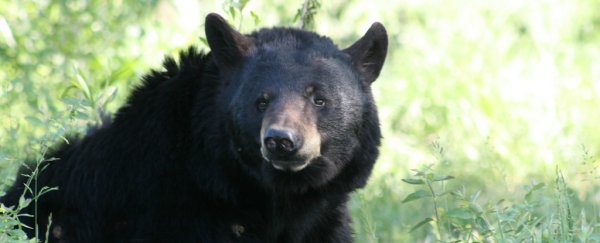Each autumn, most bear species around the world will ease up on scaring campers and scampering through the woods, and settle in a den to hibernate their way through the cold winter months.
This hibernation period tends to last for roughly six months, and during this time, some species, like the black bear (Ursus americanus), can drop their heart rates from 55 beats per minute to a mere 9, reducing their metabolic rate by up to 53 percent. Oh, and they don't poop the entire time.
Yes, bears can manage to go entire seasons without ever needing to drop a deuce, but how?
Well, to understand what's going on inside a bear's body when it hibernates, we need to first talk about what hibernation is, and why bears aren't even considered to be 'true hibernators' in the first place.
At its core, hibernation is when an animal goes into a state of complete inactivity, and blood flow and metabolic rates plummet to levels that might seem impossible for non-hibernating species like us.
Some species, like Arctic ground squirrels, are known as true hibernators because they can drop their body temperatures to below freezing, making them a living popsicle that will thaw out come spring.
Bears, on the other hand, keep their body temperatures high during hibernation, which allows them to rear cubs and stay alert to dangers that might be lingering outside their cosy dens.
Some researchers claim that this means bears are not hibernators at all, while others call them 'super hibernators' because - let's face it - being alert to your surroundings and able to keep a high body temperature without eating, moving, or pooping is pretty incredible.
"In my opinion, bears are the best hibernators," researcher Brian Barnes, from the Institute of Arctic Biology at the University of Alaska Fairbanks, who conducted a three-year study on black bears, told Jason Bittel at Slate.
"Their body is a closed system. They can get through winter with only oxygen - it's all they need."
So how do they manage to pull this off without ever having to poop? In short, they make a poop plug.
You heard that right, a poop plug.
Long ago, when researchers were first studying how bears hibernated, they commonly found masses of unidentified material inside bear intestines. Back then, they assumed that the plug was made by bears eating tonnes of plant material, bear hair, and other things that are hard to digest.
It was thought that this odd diet allowed bears to scrub their digestive tracts and create a rectal plug that literally blocked any newly-made faeces from moving until spring.
But a more recent study has found that bears don't actually eat a diet specifically to create a faecal plug. Instead, intestinal secretions and cells continue to shed during hibernation, making poop even if the bear has had nothing to eat.
"During five to seven months in dens, bears accumulate faeces in the lower 7-15 inches of the intestine to form a 'plug' 1.5 to 2.5 inches (3.8 to 6.4 centimetres) in diameter," the North American Bear Centre explains on its website.
"The faecal plug is simply faeces that have remained in the intestine so long that the intestinal walls have absorbed the fluids out of it, leaving it dry and hard."
Based on video recordings inside den, researchers have also shown that the reason plant matter and bear hair is commonly found inside faecal plugs is because bears typically spend large chunks of time grooming themselves, which causes them to eat a lot of hair from their bodies, and plant matter from the floor of their dens.
After spending up to seven months in the den, bears emerge ready to shed their faecal plugs and get on with doing other bear stuff, like teaching their cubs to hunt and finding mates.
"By the sixth or seventh month in the den, most of these bears defecate - usually near the den entrance. Faecal plugs have a light odour that is not unpleasant," reports the North American Bear Centre.
So there you have it, bears don't poop during hibernation because their bodies continue to shed cells, creating poop even without food. As this happens, hair, plant matter, and other things get eaten as the bear grooms itself.
What they're left with is a faecal plug that hardens inside their intestines. And that's a weirder answer than we could have ever predicted.
